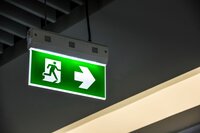Account
You are currently not logged in.
Login Forgot password?Emergency lighting plays a crucial role in ensuring the safety of individuals inside buildings. In emergencies such as power outages or other incidents, this lighting ensures that people can exit a building safely and without panic. But how does it work, and when does emergency lighting automatically activate? In this blog, we discuss how emergency lighting functions, relevant regulations and standards, and situations where emergency lighting is essential.
Emergency lighting consists of fixtures specifically designed to operate even during a complete power failure. This is made possible through built-in batteries or a central power system. When the regular power supply fails, the emergency lighting automatically switches on and remains operational for a minimum duration, usually between 60 and 180 minutes, depending on the system.
There are different types of emergency lighting:
Escape route lighting: Illuminates escape routes and emergency exits.
Anti-panic lighting: Helps to prevent panic in large spaces.
High-risk task area lighting: Provides sufficient light to safely halt potentially dangerous activities.
The activation of emergency lighting typically occurs automatically during power failures without requiring manual intervention.
Strict requirements and standards ensure that emergency lighting systems are reliable and comply with safety regulations. Key regulations include:
NEN-EN-1838: This European standard specifies the minimum light levels and performance requirements for emergency lighting.
NEN 1010: Focuses on the electrical installation of emergency lighting.
NEN-EN-IEC 60598-2-22: Covers technical requirements for emergency lighting fixtures.
Additionally, local building codes may impose additional requirements. In the Netherlands, building managers and owners are responsible for compliance with these regulations.
Emergency lighting must be regularly tested and maintained. This includes monthly and annual tests to ensure the lighting functions correctly and that the batteries have sufficient capacity. Failure to comply with these maintenance requirements can result in fines and, more importantly, create dangerous situations.
Emergency lighting is automatically activated in the following situations:
Power failure: The most common situation is a complete or partial power outage. This can be caused by technical faults, short circuits, or external factors such as severe weather conditions.
Fire alarm: In some buildings, emergency lighting is connected to the fire alarm system. When the fire alarm is triggered, the emergency lighting turns on to facilitate evacuation, even if the power is still on.
Test mode: During periodic tests, emergency lighting is manually or automatically activated to verify its functionality.
Emergency lighting not only contributes to safety but is also legally required. Without properly functioning emergency lighting, evacuations can become chaotic, increasing the risk of accidents.
Office buildings: Essential for guiding employees and visitors safely out of the building.
Healthcare facilities: Crucial for the safety of vulnerable individuals in hospitals and care homes.
Public spaces: Cinemas, shopping centers, and stadiums are required to have emergency lighting due to the large number of visitors.
Emergency lighting automatically activates during power outages, fire alarms, or tests. It is an indispensable part of a building's safety features. By adhering to legal standards and performing regular maintenance, building managers can ensure that emergency lighting reliably functions when needed.
No comments found.
